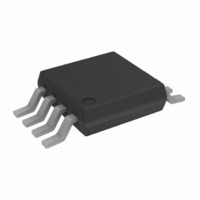AD7911ARMZ Analog Devices Inc, AD7911ARMZ Datasheet - Page 18

AD7911ARMZ
Manufacturer Part Number
AD7911ARMZ
Description
IC ADC 10BIT DUAL 2CH 8-MSOP
Manufacturer
Analog Devices Inc
Datasheet
1.AD7921ARM-REEL7.pdf
(28 pages)
Specifications of AD7911ARMZ
Data Interface
DSP, MICROWIRE™, QSPI™, Serial, SPI™
Operating Temperature
-40°C ~ 85°C
Number Of Bits
10
Sampling Rate (per Second)
250k
Number Of Converters
1
Power Dissipation (max)
20mW
Voltage Supply Source
Single Supply
Mounting Type
Surface Mount
Package / Case
8-TSSOP, 8-MSOP (0.118", 3.00mm Width)
Resolution (bits)
10bit
Input Channel Type
Single Ended
Supply Voltage Range - Analogue
2.35V To 5.25V
Supply Current
4mA
No. Of Pins
8
Sampling Rate
250kSPS
Rohs Compliant
Yes
Number Of Elements
1
Resolution
10Bit
Architecture
SAR
Sample Rate
250KSPS
Input Polarity
Unipolar
Input Type
Voltage
Rated Input Volt
5.25V
Differential Input
No
Power Supply Requirement
Single
Single Supply Voltage (typ)
3/5V
Single Supply Voltage (min)
2.35V
Single Supply Voltage (max)
5.25V
Dual Supply Voltage (typ)
Not RequiredV
Dual Supply Voltage (min)
Not RequiredV
Dual Supply Voltage (max)
Not RequiredV
Power Dissipation
20mW
Differential Linearity Error
±0.5LSB
Integral Nonlinearity Error
±0.5LSB
Operating Temp Range
-40C to 85C
Operating Temperature Classification
Industrial
Mounting
Surface Mount
Pin Count
8
Package Type
MSOP
Input Signal Type
Single-Ended
Lead Free Status / RoHS Status
Lead free / RoHS Compliant
Lead Free Status / RoHS Status
Lead free / RoHS Compliant
Available stocks
Company
Part Number
Manufacturer
Quantity
Price
Company:
Part Number:
AD7911ARMZ
Manufacturer:
ADI
Quantity:
3 000
Part Number:
AD7911ARMZ
Manufacturer:
ADI/亚德诺
Quantity:
20 000
Company:
Part Number:
AD7911ARMZ-REEL
Manufacturer:
ADI
Quantity:
3 000
Company:
Part Number:
AD7911ARMZ-REEL7
Manufacturer:
ADI
Quantity:
3 000
AD7911/AD7921
MODES OF OPERATION
The two modes of operation of the AD7911/AD7921 are
normal mode and power-down mode. The mode of operation is
selected by controlling the logic state of the CS signal. The point
at which CS is pulled high after the conversion has been initi-
ated determines whether the AD7911/AD7921 enter power-
down mode. Similarly, if already in power-down mode, CS can
control whether the device returns to normal operation or
remains in power-down mode.
Power-down mode is designed to provide flexible power
management options and to optimize the ratio of power
dissipation to throughput rate for different application
requirements.
NORMAL MODE
Normal mode is intended for the fastest throughput rate
performance. The user does not have to worry about any
power-up time, because the AD7911/AD7921 remain fully
powered all the time. Figure 26 shows the operation of the
AD7911/AD7921 in this mode.
The conversion is initiated on the falling edge of CS , as
described in the Serial Interface section. To ensure that the part
remains fully powered up at all times, CS must remain low until
at least 10 SCLK falling edges have elapsed after the falling edge
of CS . If CS is brought high any time after the 10th SCLK falling
edge but before the end of t
up, but the conversion is terminated and DOUT goes back into
three-state. For the AD7911/AD7921, a minimum of 14 and
16 serial clock cycles, respectively, are needed to complete the
conversion and access the complete conversion result.
CS can idle high until the next conversion or can idle low until
CS returns high sometime prior to the next conversion
(effectively idling CS low). Once a data transfer is complete
(DOUT has returned to three-state), another conversion can be
initiated after the quiet time, t
low again.
DOUT
SCLK
DIN
CS
1
CONVERT
CHANNEL FOR NEXT CONVERSION
QUIET
CONVERSION RESULT
, the part remains powered-
, has elapsed by bringing CS
10
12
Figure 26. Normal Mode Operation
14
Rev. 0 | Page 18 of 28
16
1
POWER-DOWN MODE
Power-down mode is intended for use in applications where
slower throughput rates are required. Either the ADC is
powered down between each conversion, or a series of
conversions can be performed at a high throughput rate and
then the ADC is powered down for a relatively long duration
between these bursts of several conversions. When the
AD7911/AD7921 are in power-down mode, all analog circuitry
is powered down.
To enter power-down mode, the conversion process must be
interrupted by bringing CS high any time after the second
falling edge of SCLK and before the 10th falling edge of SCLK,
as shown in Figure 27. Once CS has been brought high in this
window of SCLKs, then the part enters power-down mode, the
conversion that was initiated by the falling edge of CS is
terminated, and DOUT goes back into three-state. If CS is
brought high before the second SCLK falling edge, then the part
remains in normal mode and does not power down. This helps
to avoid accidental power-down due to glitches on the CS line.
To exit this mode of operation and power the AD7911/AD7921
up again, a dummy conversion is performed. On the falling edge
of CS , the device begins to power up and continues to power up
as long as CS is held low until after the falling edge of the 10th
SCLK. The device is fully powered up once 16 SCLKs have
elapsed and valid data results from the next conversion, as
shown in Figure 28. If CS is brought high before the 10th falling
edge of SCLK, then the AD7911/AD7921 go back into power-
down mode. This helps to avoid accidental power-up due to
glitches on the CS line or an inadvertent burst of 8 SCLK cycles
while CS is low. Therefore, although the device might begin to
power up on the falling edge of CS , it powers down again on the
rising edge of CS , as long as this occurs before the 10th SCLK
falling edge.
CHANNEL FOR NEXT CONVERSION
CONVERSION RESULT
10
12
14
AD7911/AD7921
16













